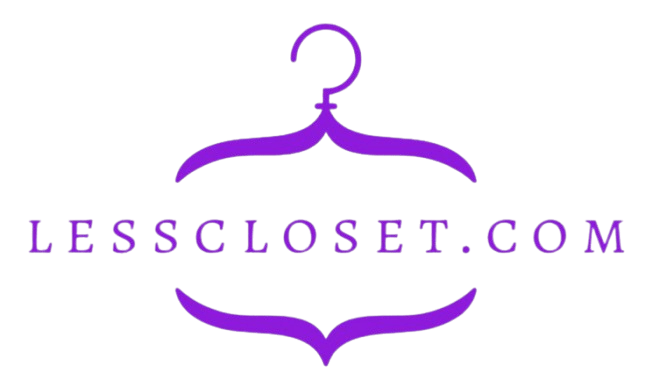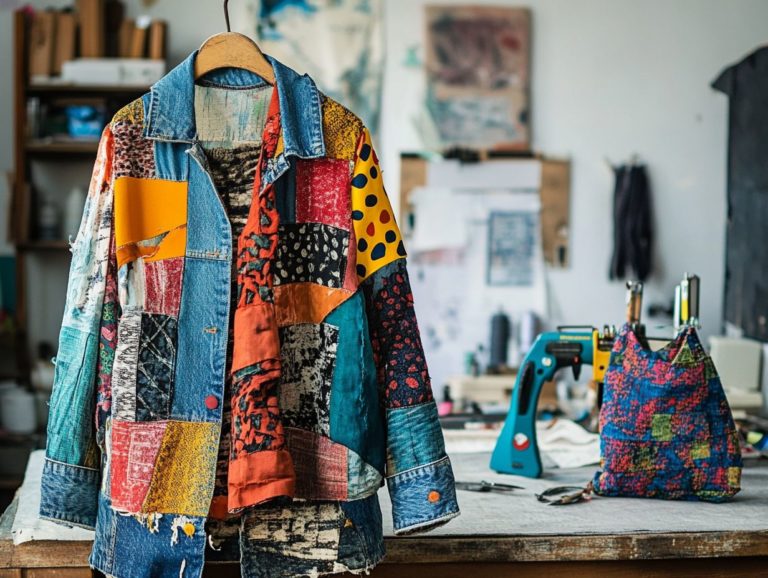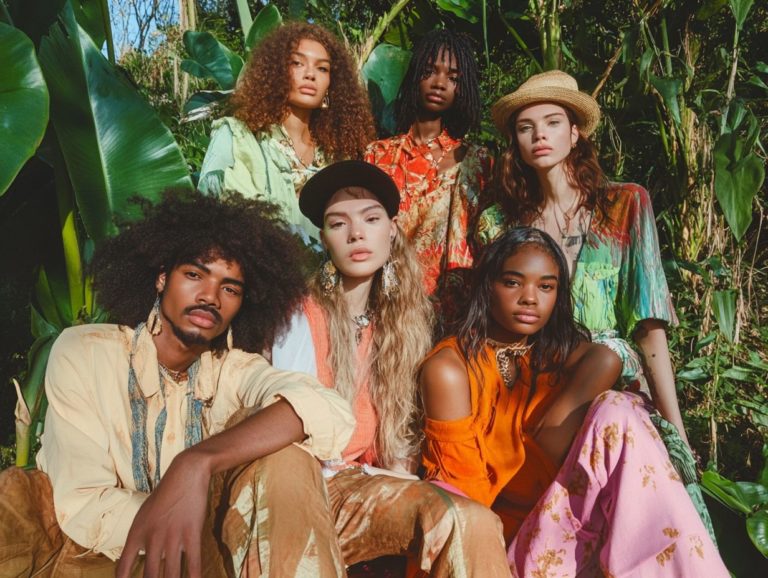Ethical vs. Sustainable Fashion: What’s the Difference?
In today’s landscape, “ethical fashion” and “sustainable fashion” often seem like interchangeable buzzwords. Yet, they represent distinct principles and practices that profoundly impact our environment and society, including pressing issues like climate change and animal welfare.
Let s dive into these essential concepts and discover how they can change your fashion choices! This article clarifies their intersection and emphasizes their importance, particularly in relation to global manufacturing practices.
You ll also find practical tips and resources to empower you in making informed choices for your wardrobe, guiding your journey as a conscious consumer.
Join in as we unravel the complexities of green fashion that prioritizes both people and the planet.
Contents
- Key Takeaways:
- Defining Key Terms
- Ethical Fashion
- Sustainable Fashion
- The Intersection of Ethical and Sustainable Fashion
- Why It Matters
- Making Ethical and Sustainable Fashion Choices
- Frequently Asked Questions
- What is the difference between ethical and sustainable fashion?
- How does ethical fashion consider the workers involved in production?
- What are some sustainable practices in the fashion industry, according to the UN?
- Is ethical fashion always sustainable?
- What are the benefits of choosing ethical and sustainable fashion?
- How can I incorporate ethical and sustainable fashion into my wardrobe?
Key Takeaways:
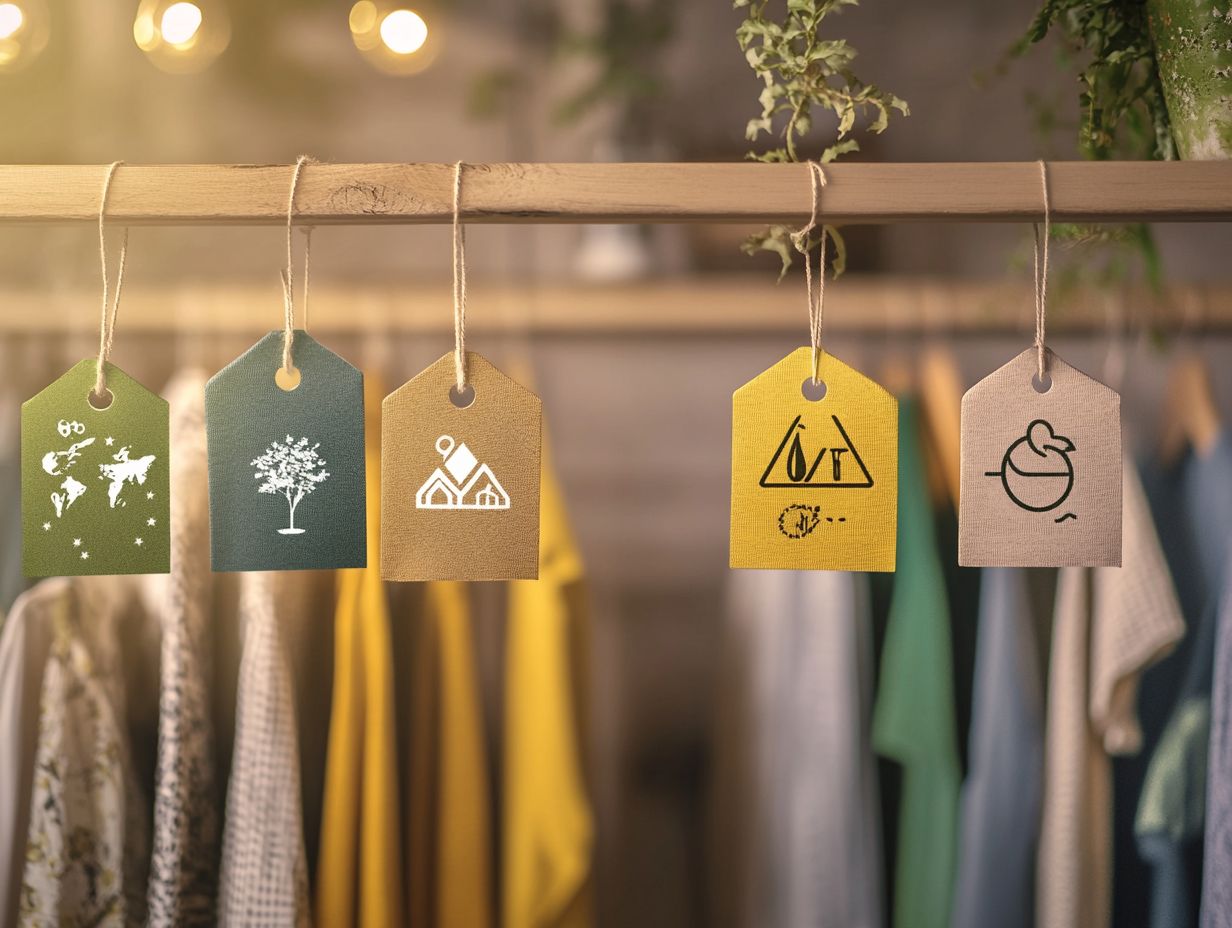
- Ethical fashion prioritizes fair treatment and working conditions for workers, while sustainable fashion focuses on reducing harm to the environment.
- The intersection of ethical and sustainable fashion aims to create a more responsible and mindful approach to fashion production and consumption.
- Making ethical and sustainable fashion choices can positively impact the environment and society, and there are resources available for consumers to make informed decisions.
Defining Key Terms
In today s fashion landscape, it s essential for you to grasp the key terms surrounding ethical and sustainable fashion, especially as a conscious consumer.
Ethical fashion focuses on clothing that prioritizes the welfare of people, animals, and the planet, while promoting vegan fashion options.
On the other hand, sustainable fashion emphasizes practices that minimize the environmental impact of clothing production. This includes the use of eco-friendly materials, particularly organic cotton, transparency within fashion supply chains, and a movement away from fast fashion toward more responsible choices that support local suppliers.
As terms like ethical clothing and sustainable fashion become increasingly significant, understanding their implications is crucial for making informed consumer choices and influencing the fashion industry as a whole.
Ethical Fashion
Ethical fashion represents a commitment to clothing production that places paramount importance on the rights and well-being of workers, as well as the humane treatment of animals involved in manufacturing processes.
This movement addresses critical issues such as child labor, unfair wages, and hazardous working conditions that persist in global manufacturing.
By embracing ethical clothing practices, brands can guarantee fair trade and uphold workers’ rights at every stage of the supply chain. This approach fosters a more sustainable and ethical fashion landscape.
Additionally, it resonates with discerning consumers who are actively seeking responsible alternatives to the fast-fashion model, promoting ethical clothing choices.
What choices will you make next for a more sustainable wardrobe?
Principles and Practices
The principles of ethical fashion focus on practices that reduce the effect on the environment while ensuring fair treatment of workers. This includes fair trade initiatives that provide equitable wages and upcycling practices that transform old clothes into new creations, reducing waste in the fashion industry.
By adopting these ethical practices, brands can create clothing that is stylish and reflects your values of sustainability and social responsibility.
Brands that use sustainable sourcing methods and commit to eco-friendly materials can reshape their environmental footprint. For example, using organic cotton cuts down on pesticide use, promoting healthier ecosystems.
A notable brand switched to natural dyes, which are less harmful than synthetic dyes, helping to reduce water pollution and greenhouse gas emissions.
Brands with transparent supply chains enhance accountability. You can trace the journey of your garments, fostering deeper trust.
As these strategies gain traction, they inspire a shift in consumer behavior. More people are demanding conscientious clothing production methods, paving the way for a more sustainable fashion landscape that champions ethical practices.
Sustainable Fashion
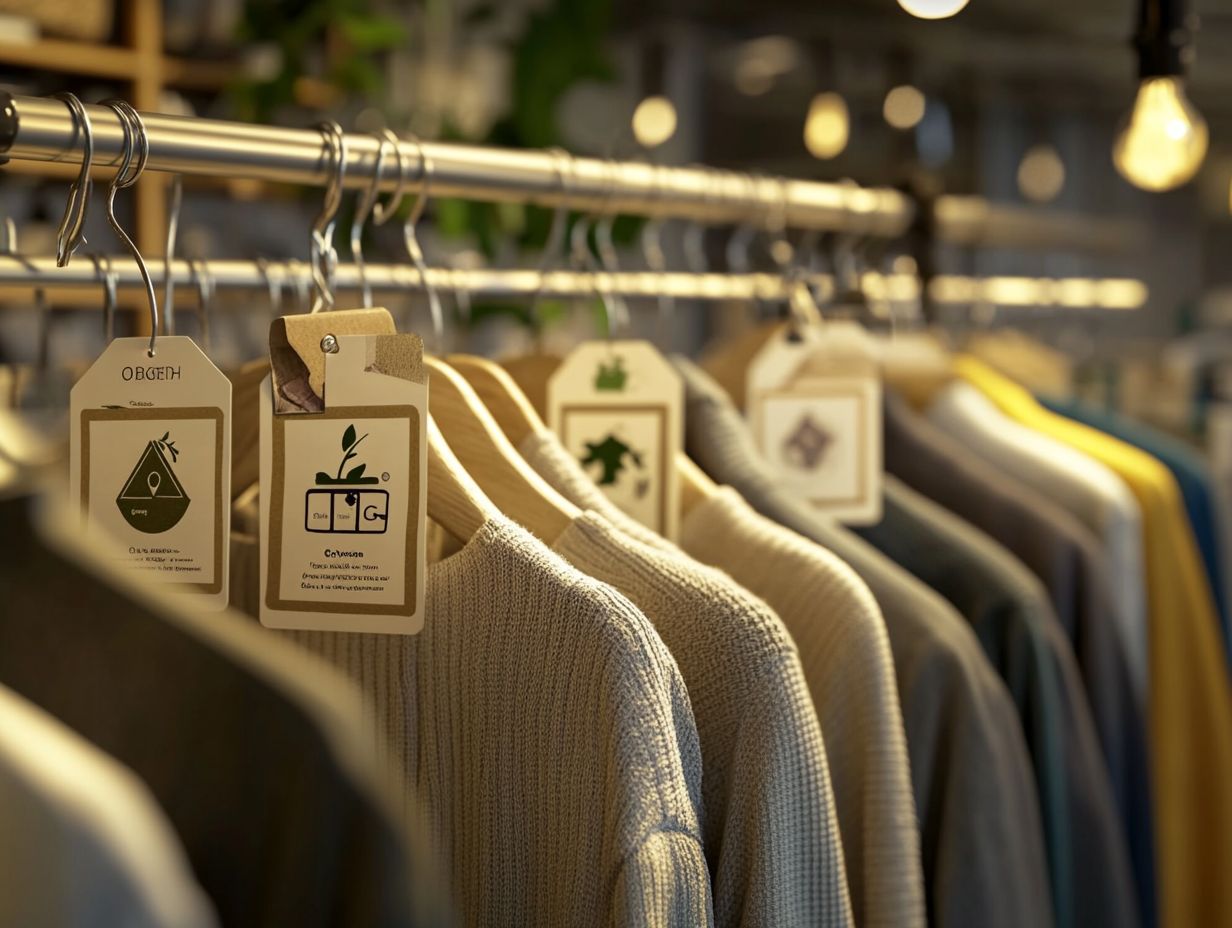
Sustainable fashion takes a holistic approach to clothing production, prioritizing eco-friendly materials. This movement aims to create garments that are stylish and environmentally responsible, minimizing pollution and waste in production.
Embracing a circular economy, which means recycling and reusing, helps counter the negative impacts of fast fashion. This approach promotes a brighter future and fosters green innovations in the fashion industry.
Principles and Practices
The principles of sustainable fashion focus on responsible clothing production and fair labor practices. This includes using eco-friendly materials like organic cotton and recycled fabrics to lessen the environmental impact at every stage.
By adopting a circular economy model, you can recycle and repurpose garments, significantly reducing landfill waste. This aligns with ethical clothing practices.
Innovative processes like waterless dyeing and energy-efficient manufacturing help brands lower their carbon footprints. These methods also promote animal welfare.
Many companies emphasize transparency in their supply chains, allowing you to make informed choices that match your values. Community-oriented initiatives and ethical labor practices drive sustainable development, supporting workers’ rights.
As awareness of these sustainable practices grows, it’s clear that your consumer choices can lead to meaningful changes in the fashion industry.
The Intersection of Ethical and Sustainable Fashion
The intersection of ethical and sustainable fashion is a vibrant movement in the fashion industry. It aligns your consumer choices with responsible practices, tackling issues like climate change.
Both approaches highlight the importance of worker welfare and environmental health. They encourage brands to practice transparency and use eco-friendly materials.
Understanding how these two movements overlap empowers you to make informed choices that reflect your values. This way, you help shape a fashion industry committed to ethical practices and sustainability.
How They Work Together
Ethical fashion and sustainable fashion come together to create a comprehensive approach to the clothing industry. They emphasize both environmental sustainability and social responsibility while promoting ethical clothing for all consumers.
Using eco-friendly materials and ensuring workers’ rights is crucial. These movements enable you to make informed choices that positively impact both the planet and its people.
They create a foundation for a fashion industry that prioritizes ethical practices and long-term sustainability.
Support brands like Patagonia and Eileen Fisher. They use sustainable materials and ensure fair labor practices in their supply chains. This showcases how ethical considerations can beautifully complement environmentally friendly innovations.
Your choices matter. By backing these brands, you encourage responsible production methods and demand transparency in the industry.
As the conversation around fashion evolves, it s essential for you to recognize that your purchasing decisions can either contribute to the problem or inspire a more equitable and environmentally sound industry. When ethical and sustainable practices align, they boost brand integrity and create excitement for consumers.
Prioritize your choices. Act now to support brands that prioritize sustainability and ethics.
Why It Matters

Understanding the importance of ethical and sustainable fashion is essential in today s world. The repercussions of fast fashion and climate change loom large, impacting global manufacturing practices.
The fashion industry stands as one of the foremost contributors to greenhouse gas emissions. By championing ethical fashion, you can tackle pressing issues such as animal welfare, labor exploitation, and the need for fair trade practices.
Embracing sustainable fashion practices lessens environmental impact. It fosters a more responsible consumer culture, paving the way for meaningful social and environmental transformation, ultimately contributing to our circular economy, a system where products are reused and recycled to minimize waste.
Impact on Environment and Society
The impact of ethical and sustainable fashion on the environment and society is profound. These movements strive to counter the harmful effects of fast fashion and global manufacturing practices while alleviating issues like child labor and unfair wages.
By prioritizing sustainable materials and ethical production methods, you can help the fashion industry significantly reduce its carbon footprint and contribute to climate change mitigation. This ultimately promotes a culture of mindful consumption.
Ethical fashion also champions social justice. It advocates for fair labor practices and improved working conditions for garment workers around the globe, emphasizing the importance of workers’ rights.
This approach benefits the environment and enables communities, paving the way for a more equitable industry. For example, a report from the Ellen MacArthur Foundation highlights that if the global fashion industry embraced circular economy principles, it could slash greenhouse gas emissions by nearly 70% by 2030.
Brands committed to ethical practices often enjoy higher employee satisfaction and retention, fostering a positive workplace culture.
By choosing sustainable alternatives, you support an industry that values both people and the planet. This ultimately drives meaningful change and sets a precedent for future generations.
Making Ethical and Sustainable Fashion Choices
Making ethical and sustainable fashion choices is essential for you if you want your clothing purchases to reflect your values. By selecting brands that emphasize eco-friendly materials and maintain transparency throughout their supply chains, you can support ethical practices and foster a more responsible fashion industry.
As conscious consumerism continues to rise, you are becoming more aware of the impact your clothing choices have. This awareness encourages brands to embrace more sustainable and ethical practices.
Your Guide to Ethical Fashion Choices!
If you re looking to make ethical clothing choices, there are plenty of tips and resources available to enhance your journey toward sustainability and transparency in fashion.
Start by exploring websites like Good On You. This site provides ratings and insights into a brand s environmental impact, labor practices, and animal welfare initiatives.
Apps such as the Ethical Style Guide give you comprehensive information right at your fingertips. You can assess brands while you shop, making informed decisions easier.
Dive into publications like The Good Trade or Eco-Age. These platforms keep you updated on current trends and innovations in sustainable fashion.
When evaluating brands, watch for certifications like GOTS for organic textiles and Fair Trade seals. These indicators show adherence to ethical practices.
By integrating these resources into your purchasing habits, you can make informed decisions that truly align with your values. Join the movement for change today!
Frequently Asked Questions

What is the difference between ethical and sustainable fashion?
Ethical fashion refers to clothing production and sourcing that is fair to both workers and the environment. Sustainable fashion focuses on the environmental impact of a product’s entire lifecycle, from sourcing materials to disposal.
How does ethical fashion consider the workers involved in production?
Ethical fashion ensures fair treatment of workers, including a living wage, safe working conditions, and no forced labor or discrimination.
What are some sustainable practices in the fashion industry, according to the UN?
Sustainable fashion uses eco-friendly materials, reduces waste and carbon emissions, and promotes circular fashion through recycling and upcycling initiatives.
Is ethical fashion always sustainable?
While ethical fashion emphasizes fair treatment of workers, it may not always prioritize environmental sustainability. For instance, a brand may use organic cotton but still produce excessive waste.
What are the benefits of choosing ethical and sustainable fashion?
Choosing ethical and sustainable fashion allows consumers to support fair labor practices and reduce their environmental impact. This approach contributes to a healthier planet and a more ethical future for all.
How can I incorporate ethical and sustainable fashion into my wardrobe?
Start by researching and supporting brands that prioritize ethical and sustainable practices. Consider buying secondhand or renting clothing, and take good care of your clothes to extend their lifespan. Every small effort can make a big difference in promoting ethical and sustainable fashion.
